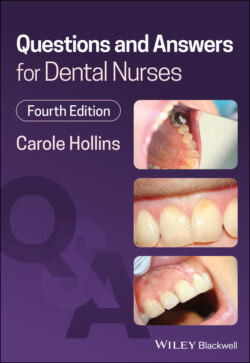Читать книгу Questions and Answers for Dental Nurses - Carole Hollins - Страница 15
1 Communication Skills Multiple choice questions
Оглавление1 Most dental workplaces will treat patients of a wide age range, from young children to elderly pensioners, and the communication skills required by the team to treat each group successfully varies greatly. Which one of the following options is the least likely communication skill to achieve successful toothbrushing compliance by a primary school‐age child?Able to ask questions of teamAppropriate vocabulary for ageDescribing likely dental treatmentHands‐on teaching techniqueUse of physical aids to teach
2 The act of communicating with someone is to give or exchange information with them, and this can be done both verbally and non‐verbally. Which one of the following non‐verbal communication actions would indicate that the listener is indeed listening to the speaker?Breaking eye contactContinuing another taskFacing themInterrupting themTurning from them
3 During a dental appointment, patients are often provided with a lot of information by the dental team: oral health advice, treatment advice, discussions of treatment options, etc. Sometimes it may be difficult for them to clearly remember all that has been mentioned. Which one of the following options is the preferred method of reinforcing the information so that the patient remembers it?Ask a colleague to repeat itAsk the dentist to repeat itProvide it in written format Repeat it at the next appointmentRepeat it during the appointment
4 From time to time the dental team will provide treatment for patients with a disability such as reduced vision or partial sightedness. Good communication skills by the team are important in ensuring that these patients receive treatment in a safe manner and are comfortable doing so. Which one of the following options is the least likely communicative action to assist partially sighted or blind patients to undergo dental treatment?Describe likely sensationsDescribe likely soundsPlay music during treatment sessionProvide information in BrailleUse magnifiers for written information
5 Good communication skills are of great importance in encouraging patients to take an active role in managing their own oral and general health. If the person advising them has poor communication skills, the patient is unlikely to follow the advice. Which one of the following options would indicate communicators have good communication skills when advising a patient?Butting in verballyFolding their armsRolling their eyesSitting downTurning away
6 The requirement for the dental team to communicate effectively with patients is enshrined in the General Dental Council (GDC) Standards document. Which one of the following options is the specific core ethical principle of professionalism in this document that deals with the issue of communication skills?Principle 1Principle 2Principle 3Principle 4Principle 5
7 In modern dental workplaces, patients often receive various stages of treatment and oral healthcare from several members of the dental team throughout the delivery of a treatment plan. It is therefore important that all team members give the same messages so that the patient does not become confused. Which one of the following options is the most likely method used by the team to avoid giving conflicting advice to patients?Copy what the dentist says‘Google’ the topicHave a written protocol Learn the message by roteRefer to a textbook
8 Many dental workplaces deliver oral healthcare and treatment to patients in a multiracial society and for many of those patients, English is not their first language. It is important that patients understand the information they are given, otherwise they cannot give valid consent for treatment. Which one of the following options is the least effective method of giving dental information to a non‐English‐speaking patient?Allow family to interpretIssue relevant NHS leafletTalk slowlyUse ‘Language Line’ serviceUse suitable online translation
9 From time to time the dental team will provide treatment for patients with a disability such as hearing loss or profound deafness. Good communication skills by the team are important in ensuring that these patients receive treatment in a safe manner and are comfortable doing so. Which one of the following options is the least effective method of communicating with a partially deaf patient?Remove mask while talkingShout instructionsSit facing patient while talkingUse hearing loop deviceWrite down information
10 Most dental workplaces will treat patients of a wide age range, from young children to elderly pensioners, and the communication skills required by the team to treat each group successfully vary greatly. Which one of the following options is a patient age range that is most likely to respond to receiving oral health advice in short interactive sessions?PensionersPrimary schoolTeenagersToddlersUniversity students
11 Sometimes, despite the best efforts of the dental team, the ability to communicate the detrimental effects of patients’ habits or actions on their oral and general health fails. Patients have the right to make their own decisions, of course, in all matters concerning their own oral and general health, and the dental team must respect this. Which one of the following options is the most likely communication method to impress an otherwise non‐receptive patient?Accept defeat and give no further adviceProvide relevant statisticsRelay success of other patients Reprimand the patientShow a relevant photograph
12 Good communication skills are required by all members of the dental team when dealing with patients, to ensure that the patients can give consent for any treatment proposed by the team. Which one of the following options is an example of a team member showing good communication skills when dealing with a patient?Giving no informationLeaving questions unansweredSpeaking a different languageUsing clinical picturesUsing dental terminology
13 Good communication between the dental team and their patients is crucial in providing relevant oral and general health information, for the benefit of the patients. Which one of the following options is an example of verbal communication?Discussing a treatment planGiving an information leafletListening to a complaintMaking eye contactSmiling at the patient
